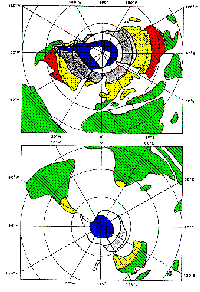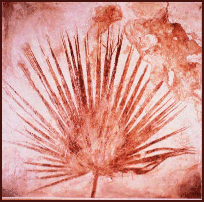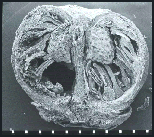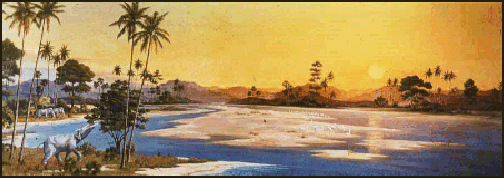
The consistency of angiospermous floras in the Arctic of the northern hemisphere has been suggested to be heterochronous by Hickey and others. That is, the vegetation in the high arctic paleolatitudes is characterized by a palynoflora that is of Early Paleocene (of the mid-latitudes) in aspect. The megaflora has reported to follows this trend; that is, the leaf assemblages of these Arctic floras appear to be at least 1/2 stage/epoch ahead (18 million year phase shift) of the lower latitudinal floras. By the beginning of the Eocene, the floras are synchronous. This observation has led Hickey and others to suggest that certain taxa (i.e., Metasequoia occidentalis & "Carya" antiquorum) probably evolved at high latitudes and migrated southward during climatic deterioration, while diversity gradients in the remainder of the Cretaceous show higher diversity at low-latitudes.
In the late Cretaceous and Early Tertiary, the northern hemisphere continents were vegetated by a flora that was nearly cosmopolitan. There has been considerable question as to the relationship of the eastern Asia and both western and eastern US floras because they both have similar systematic affinities.
Hsu has suggested that there was a direct migration between these portions of the northern continents with the development of a modern flora after the Eocene. The similarities between these two extant floras has been interpreted to represent a remnant distribution based on temperature centers.
Latitudinal organization of early Paleocene vegetation was different from that of the Late Cretaceous. Assemblages north of 50oN paleolatitude represent broad-leaved deciduous forests (low proportion of entire-margined taxa), which is about 10-15o south of their Late Cretaceous limit. Assemblages south of 50oN paleolatitude exhibit characteristics of broad-leaved evergreen forest; those from 46oN and south (Raton Basin and Gulf Coast) have a high proportion of entire-margined taxa reflecting megathermal conditions.
 |
Wolfe's suggested vegetational map of the latest Paleocene-early Eocene with continental positions adapted from Smith et al. (1981). Tropical rainforest=Green; Paratropical rainforest=Yellow; Broadleaved evergreen forest=Black; Mixed northern hardwood forest=Transparent |
|---|
The trend into the Eocene reflects a return to dominance of broad-leaved evergreen plants in the northern Rocky Mountains, followed by significant drying in the Western Interior and eastern North America. The dry-season deciduous vegetation continued into the early Oligocene.
 |
Wolfe's suggested vegetational map of the late middle Eocene with continental positions adapted from Smith et al. (1981). Tropical rainforest=Green; Tropical/Paratropical semideciduous rainforest=Orange; Paratropical rainforest=Yellow; Broadleaved evergreen forest=Black; Mixed northern hardwood forest=Transparent; Mixed coniferous forest=Blue |
|---|
Wolfe has stated that the Late Cretaceous-Early Tertiary generally had a higher temperature and equitability through the Paleocene, with a deterioration in climate near the terminal Eocene event . The Paleocene vegetation includes magnolias, Ficus (figs), and other typically subhumid to subtropical plants. Several of these taxa are now restricted to Central America.
 |
|
|
Floras from Oligocene strata depict a change in climate, with the beginning of a cooling trend that is accompanied by temperate-character forests. This continues into the early Miocene, although a slight warming trend is apparent in the mid-Miocene of the middle latitudes. This is in spite of the fact that Alaska began to experience glaciation. Mid-latitude floras reflect changing rainfall conditions, with floristic representatives presently found in the southeastern US (e.g., Magnolia, Liquidambar, and Ulmus). |
 |
By the Pliocene, Asian and southeastern US taxa are no longer found in the region. The present-day flora is essentially established in this area. The vegetation records a gradual climate shift to cooler and drier conditions, and culminated in the Pleistocene with the inception of continental-scale glaciation.
Before the end of the Tertiary, the forests in the western US become dominated by conifers (Wolfe, 1979). A similar pattern is seen in Europe where, in the Pliocene, Sequoia is dominant in some regions. Taxodium-dominated lowland swamps, with taxa similar and identical to those found in the Holocene flora of the southeastern US, existed in northern Europe (Denmark, German, Netherlands). This mixed conifer-deciduous forest extended into the Quaternary. Wolfe emphasizes that the loss of conifers in the Quaternary of Europe is an important vegetational and, hence, climate change.

The southeastern US has undergone a similar vegetational change in the Early Tertiary, although it differs slightly.
During periods of maximum glaciation in the Pleistocene, temperate hardwood forests appear here and in northern Mexico. Reconstructions of global vegetation patterns in the Pleistocene are available in the Global Atlas for Paleovegetation.
Cenophytic floras in this hemisphere are varied in diversity.